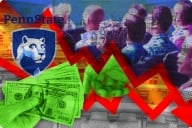You have /5 articles left.
Sign up for a free account or log in.
While tuition and fees continue to rise at a fast pace, particularly at public colleges and universities struggling with declining state appropriations, federal financial aid policies have kept down the price students pay for a college degree, according to two annual reports released today by the College Board on tuition and financial aid.
In all sectors of higher education, tuition prices increased at least 4.5 percent over 2010-11’s published rates, while the Consumer Price Index, a standard measure of inflation, rose about 3.6 percent. Public institutions, which educate the majority of college students, saw the largest percentage increases. In-state students at four-year public colleges and universities saw their bill rise an average of 8.3 percent, and community college tuition went up an average of 8.7 percent.
While sticker prices have gone up in all sectors, the financial aid report finds that changes in aid policies, particularly at the federal level, have helped keep down the amount students end up paying after grants and tax credits. When figures are adjusted for inflation, students in some sectors are actually spending less on tuition than they did in 2006-7.
Sandy Baum, a policy analyst for the College Board and co-author of the reports, said the federal government is stepping in to fill a financial void created by states' decreased ability and willingness to fund public colleges and universities. “In a way, the burden of paying for higher education is shifting from the states to the federal government,” she said.
How the federal role will evolve in uncertain. Many in higher education worry that Pell Grants and other aid programs are vulnerable to Congressional deficit-cutting efforts. But President Obama plans today to propose ways to reduce the size and duration of student loan repayments for many borrowers.
Tuition Increases by Sector, 2011-12
| Sector | 2011-12 Tuition and Fees | One-year dollar increase | Percent increase from 2010-11 to 2011-12 | Percent increase from 2009-10 to 2010-11 |
| Private, nonprofit four-year colleges | $28,500 | $1,235 | 4.5% | 4.5% |
| Public four-year colleges, in-state residents | $8,244 | $631 | 8.3% | 7.9% |
| Public, four-year colleges, out-of-state residents | $20,770 | $1,122 | 5.7% | 6.0% |
| Community colleges | $2,963 | $236 | 8.7% | 6.0% |
| For-profit colleges | $14,487 | $447 | 3.2% | 5.1% |
Baum said the reports’ findings should be put in the context of the current economic climate, which is making it harder for many families to afford college educations. “We’re operating at a time of persistent high unemployment and declining incomes,” she said.
The report attributes the large increases in public-college tuition rates over the past few years to decreased per-student state appropriations. Since the recession that started in fall 2008, state revenues have not kept pace with inflation and enrollment growth in many states, and many lawmakers have been reluctant to cover the difference through tax increases. As a result, per-student spending on higher education has declined. According to the College Board report, state appropriations decreased 18 percent per full-time student between 2007-8 and 2010-11, the largest three-year decline in the 30-year period covered in the report. While declines have happened in a cyclical manner in the past, recent declines have been greater than in the past. "The recent decade tells a different story than earlier decades," Baum said. Over the past decade the decrease in per-student funding is 23 percent.
“It is particularly troubling to see that over the past decade, state funding at colleges and universities has fallen 23 percent per student after inflation,” the American Council on Education's president, Molly Corbett Broad, said in a statement. “That number shows it has become all too common for state legislatures to dip into the pockets of students and families to balance state budgets, leaving public institutions between a rock and a hard place when setting tuition rates.”
Significant diversity exists across states, and averages rarely tell the story about how changes have played out for individual students. Some states that were not as hard-hit by the recession continued to spend at pre-recession levels. At the high end are Wyoming and New Mexico, which in 2010-11 spent $14.38 and $12.73 -- respectively -- for every $1,000 in personal income on higher education. At the other end are New Hampshire and Colorado, which spent $2.44 and $3.57, respectively, for every $1,000 in personal income.
Because most institutions' per-student state appropriations have declined, college and university presidents say they have been forced to raise tuition prices to maintain operations and educational quality, pay faculty salaries, and ensure financial aid.
California’s large tuition increases last year -- 21 percent at public four-year colleges and 37 percent at two-year colleges -- drove up averages. Without the California hikes, the average increase at public four-year institutions would have been 7 percent, and the average at two-year institutions would have been 7.4 percent. Despite the large increases, students at California's two-year institutions still pay less than community college students do in other states. Other states with large tuition increases at public four-year institutions included Arizona (17 percent) and Washington (16 percent). At the other end of the spectrum were Connecticut and Colorado, where increases were about 2.5 percent.
The Delta Project on Postsecondary Education Costs, Productivity, and Accountability, which attempts to address the cost side of the higher education question, also attributed the increase in tuition prices at public institutions in 2009, the most recent set of data covered by the project's reports, to decreased state appropriations.
Baum said the model of funding public colleges has broken down at a fundamental level, and that colleges need to find alternative means of financing their enterprise. In the past few years, several public colleges and universities have begun looking for alternative means of supporting undergraduate education or using tuition hikes and public pressure to secure state appropriations.
At the same time that state appropriations and aid programs are shrinking, the report credits the federal government for limiting the impact of rising tuition on students. Stimulus money between 2008-9 and 2010-11 helped many colleges maintain their spending levels. In 2010 Congress approved changes to the Pell program that made more students eligible for aid and increased the maximum award to $5,550. As a result, expenditures for the program rose from $18.1 billion in 2008-9 to $34.8 in 2010-11. The average Pell Grant awarded also increased from $2,945 in 2008-9 to $3,828 in 2010-11.
The huge increase in Pell Grant spending, which surprised lawmakers in 2009, has not been viewed positively by all. Lawmakers of both parties, including the president, have proposed ways to restrict the program and scale back the amount distributed, saying it is unsustainable to continue funding it at the same level. It has also led some critics to assert that the expanding federal aid is feeding the tuition increases, although Baum and other economists rebut those arguments.
The American Opportunity Tax Credit, which was introduced as part of the stimulus plan in 2009, was another driver of increased federal aid. The credit increased total tax savings for college students and their families from $6.6 billion in 2008 to $14.7 billion in 2009.
While declining state appropriations might account for the most recent tuition hikes, it doesn’t tell the whole story, since tuition has been rising faster than inflation for decades before the recent downturn and continues to rise at private institutions. Even in years when state coffers were full and public colleges did not need to raise new revenues to fill budget holes, the data in the report show that public colleges increased tuition prices. In 2003-04, public four-year colleges and universities increased tuition and fees 11.0 percent beyond inflation, the largest one-year increase.
The College Board’s report does not focus on why the cost of college is going up. According to the Delta Project, the amount that colleges spent increased at least two percent above inflation for each category of institution between 2004 and 2009. Increased costs have been pinned on everything from administrative bloat and a complex organizational structure to a reluctance to cut outdated programs or adopt technological changes.
Patrick M. Callan, president of the National Center for Public Policy and Higher Education, has said the reluctance to address the cost issue is the real culprit. His organization has called for colleges to adopt several cost-saving measures to drive down how much an institution spends per student, savings that could be passed on in the form of lower tuition. He also pins it on state governments to enact policies such as tuition caps to keep costs down.
Institutions might be reluctant to cut unilaterally because expenditures are regularly seen as a signifier of educational quality. Financial resources per student account for 10 percent of an institution’s U.S. News & World Report ranking, and faculty compensation makes up another 7 percent.
While private college tuition increased at a smaller percentage than public college tuition, private institutions' sticker prices were much larger to begin with, so the dollar figures are much more. Several colleges in the past year have cut tuition, or capped the size of increases. Others, particularly residential liberal arts colleges, have started to wonder whether the model is sustainable.
As in other years’ reports, the College Board is quick to point out that most students are not paying the $50,000 sticker prices that tend to grab headlines. The average cost of tuition for in-state students at four-year public universities, even after several years of large percentage increases, is still $8,244. At private nonprofit institutions, which tend to generate headlines for high tuition, the average sticker price is $28,500.
And those prices are before governmental and institutional aid kick in. According to the report, about two-thirds of students receive some form of aid. While the sticker price increased by about $1,800 between 2006-07 and 2011-12 at public four-year institutions, the amount that students actually paid, often called net price, only increased about $170. At private colleges and universities, sticker price increased $3,730 over the same time period but the actual price paid by students declined by $550 in inflation-adjusted dollars. According to a survey by the National Association of College and University Business Officers, students paid an average of 57.6 percent of the sticker price.
In a statement, David L. Warren, president of the National Association of Independent Colleges and Universities, said the association’s member institutions are working hard to keep net tuition, not necessarily sticker price, down.
"More institutions are introducing creative measures to reduce students’ out-of-pocket costs, including three-year bachelor’s degrees, tuition freezes and cuts, programs that replace loans with grants, programs that match the price of local state universities, and other initiatives," he said.
The report notes that net price will only become more relevant once colleges implement net price calculators, which they are mandated to do by the end of the month by the federal government.
While aid programs have kept net tuition prices relatively steady, Baum noted that the main barriers to an affordable education are non-tuition expenditures such as book and living costs. Aid programs tend to cover tuition costs, but students must still find a way to pay rent, she said.








